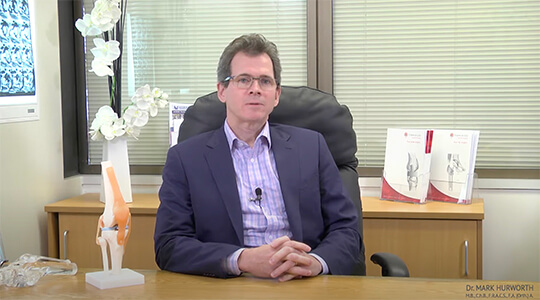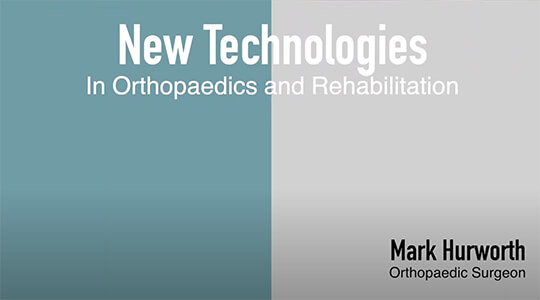Kneecap dislocation Perth
Best treatment options for kneecap dislocation
When your kneecap (patella) has been dislocated, then you may need the help of a knee specialist. On this page, we will go over the basics and discuss your best treatment options.

My orthopaedic practice in a nutshell
Kneecap dislocation symptoms
What is it and what are the symptoms?
When your kneecap dislocates, it almost always happens laterally ie towards the outside of the knee. If it stays out of joint, you may see an obvious and very painful deformity.
In some situations though, a kneecap dislocation may be quite subtle, for example in adolescent girls. Teenage girls are more unstable than boys due to hormonal influences, and therefore more likely to sustain these injuries, as they are ACL injuries.

Mr Mark Hurworth, Knee surgeon Perth
“Kneecap or patella dislocations are common in teenagers. They often happen when an adolescent is playing sport and there may be some confusion if the injury is mistaken for an ACL injury and vice versa. If your kneecap stays dislocated, you will need to go to the emergency department to have it put back into position.”
If you suffer from a single dislocation, we can often manage it with judicious rehabilitation exercises. The focus is to help you regain muscle control, strength and bulk. But if instability persists despite appropriate rehabilitation, it will affect your confidence and that is when we may need to look at surgical options.
Diagnosis kneecap dislocation
How is it diagnosed?
If you come and see me as your knee specialist, the first thing I do is ask you questions – we call it taking a history – about what happened, so make sure you have a clear picture in your own mind about the circumstances of the injury, how long it was out for, how it popped back in etc. I will also examine your knee.

Mr Mark Hurworth, Knee surgeon Perth
A simple X-ray will show if your kneecap is actually dislocated. Typically we will also obtain an MRI to look closely at the soft tissue structures. If your kneecap stays dislocated for a long period, or it dislocates frequently, we will look at the MRI information to give you a clear diagnosis, assess your anatomy and discuss your best treatment options.
Story continues below video gallery
Videos about knee conditions and surgeries
Avoid kneecap dislocation surgery
Can I avoid surgery?
As a teenager
If you are a teenager, growth happens at growth plates (physes) on either side of your knee and this can occur rapidly. Typically the knee may be prone to injury if you are engaging in a lot of sporting activity during periods of rapid growth. In addition, teenage girls may experience hormonal fluctuations that make the knee loosen up. If your kneecap only dislocates once, especially if you are still growing, I may discuss nonoperative management with you.
What this means is that we work together to strengthen your muscles (especially the quadriceps). The type of management and training I use in these situations is based on using a static bicycle at low to moderate intensity. You are at the right intensity if you can still have a conversation. We normally work towards three sessions of half an hour, building up to three hours per week.
As an older patient
If you are older when you dislocate for the first time, this will affect the pattern of injury in your knee. It is worth having an MRI scan as soon as possible to clarify the damage. A single dislocation is generally not a reason to have surgery. But if you dislocate your knee on a regular basis, after appropriate nonoperative management, then we may need to consider surgery.
I will keep repeating it: getting on a static bike as soon as possible after injury is a key element in any treatment plan if we are aiming to get the motion and strength back that you enjoyed before your injury. Remember: motion is lotion.
A personalised approach
Every knee is different and I will provide personalised recommendations after I have examined your knee and your X-rays or MRI images. If the anatomy of your knee predisposes your kneecap to dislocate more easily, we may discuss the possibility of having knee surgery.
In other situations, a kneecap dislocation causes other damage: for example the kneecap knocking off a piece of cartilage. That piece could lock up your knee and this almost certainly means that you will need surgery. If your kneecap remains unstable and keeps dislocating despite appropriate rehabilitation then surgery may be the only way forward. Typically in these cases, an MRI and possibly a CT may be performed to assess the anatomy of your knee in more detail.
Many of my Perth patients are surprised to hear that we can sometimes avoid surgery altogether. The management plan to get there depends on your injury but these are the typical ingredients:
- Judicious exercises – especially closed chain to strengthen quadriceps and hamstrings
- Avoiding certain activities and specific movements of the knee
- Using anti-inflammatories to reduce swelling
As you will see, no treatment plan should be based on “not using your knee at all”. If you stop moving your knee, it will become more unstable due to loss of muscle mass and strength. Typically the initial injury may by accompanied by feelings of recurrent instability, but this is often because of muscle wasting and loss of confidence in the knee, and does not mean that surgery is inevitable. We would always encourage a period of rehabilitation after kneecap dislocation to get back to the best condition possible before considering surgery.
Sometimes a soft brace is used to make your knee more stable and more comfortable. I encourage my patients to stay away from rigid braces, as they lead to more muscle wasting.

Kneecap dislocation surgery
What would surgery involve?
If we decide that surgery is required for your instability or issues related to it, then there are a few options that may be appropriate at my practice in Perth (at Saint John of God Murdoch Hospital):
- Arthroscopy: this procedure is suitable if a loose fragment is locking up the knee, and for treating minor maltracking problems.
- Medial Patellofemoral Ligament or MPFL reconstruction surgery: used if you have recurrent instability despite appropriate rehabilitation. We tighten the knee up on the inside using tissue from elsewhere in your body: typically a hamstring or a quadriceps graft.
- Sometimes we need to move bits of bone around such as the insertion of the patella tendon (tibial tubercle transfer).
- If there is a lot of cartilage damage we will sometimes need to graft the defects (cartilage graft).
Patients from all around Perth metro area come to see us at the practice and one of the questions my reception team often gets is: how do I prepare to undergo surgery for a patella instability, or knee surgery in general?
There is no one-size-fits-all advice, and I will personalise my advice based on your examination, your injury and the treatment plan. Typically the preparation revolves around time spent on a static bicycle and other closed chain exercises, emphasising regaining muscle tone and resilience . We prefer where possible that you undergo an exercise program to strengthen your knee as much as you can prior to surgery. We then also give you a program after surgery to support your recovery.
Recovery after kneecap dislocation
How long will recovery take?
After knee injury the first priority is to come to a clear diagnosis, then work out what treatment is appropriate and when – surgical or non-surgical. Often non-surgical treatment is worth trying in this condition before considering surgery. The other big question is: will my knee return to normal, and when?
If you are talking about sport at a high level, it can take up to a year to get back to elite level and a lot depends on your level of conditioning before you go into surgery. This is quite similar to the recovery times for an ACL injury.

Mr Mark Hurworth, Knee surgeon Perth
“Your quadriceps muscle will often lose strength dramatically after this type of injury, but also as a result of surgery. That’s why I emphasize the importance of getting your knee in the best possible shape before considering surgery.”
I sound like a broken record player but some things just need repeating: moving and strengthening your knee as much as possible is essential after this sort of injury, and before considering or proceeding with surgery. A lot of initial symptoms will resolve once the muscles are reactivated and trained after a dislocation event.
It may sound counterintuitive to do any exercise at all, due to feelings of instability. Our research confirms, however, how safe and beneficial a static bicycle is in this situation. It’s a controlled, closed-chain exercise and it makes a big difference.

Mr Mark Hurworth, Knee surgeon Perth
Even if we can’t avoid surgery, your recovery becomes a lot more effective if your knee is properly rehabilitated prior to surgery. Again, not having prepared adequately for surgery in this area is a bit like doing the long-jump or high-jump from a standing start.


